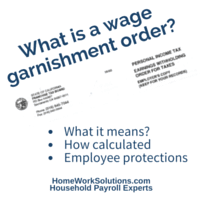
How is it decided how much is deducted from an employee’s pay to satisfy the wage garnishment order?
Federal law (Title III of the Consumer Credit Protection Act) protects the employee from creditors as follows:
- Prohibits an employee from being fired due to a wage garnishment order
- Limits the amount that can be withheld from the employee’s paycheck to satisfy the creditor
The formula to determine the amount that can be deducted is based on the employee’s net earnings or disposable pay. This is the employee’s normal take home pay. In general for household employees, the garnishment amount for debts other than child support and alimony may not exceed 25% of the net pay. Child support and alimony debts may reach 50% of disposable pay. The garnishment order itself will provide instructions on how this garnishment amount is calculated. The employer must adhere to these calculations. The only way this can be changed is by another amended garnishment order, or the dismissal of the garnishment order. Both of these actions must be initiated by the employee directly with the agency ordering the garnishment.
Questions regarding employer wage garnishment orders should be referred to the agency initiating the withholding action.
What is the employer’s responsibility regarding a wage garnishment order?
Employers are responsible to comply with the garnishment order or face disciplinary action. An employer who does not comply with the order may find themselves facing court order, or in some cased becoming legally responsible for the uncollected employee debt.
- The employer is responsible to provide the employee with a copy of the garnishment order.
- The employer is responsible to begin making deductions with the next available pay date.
- The employer is responsible to acknowledge the garnishment order per the order’s instructions.
- The employer is responsible to forward the garnished wages to the ordering agency per the order’s instructions, typically on a pay period basis.
How does a garnishment order end?
- Some orders have an end date.
- Most orders end when the agency initiating the withholding action sends notice to the employer of termination of the garnishment order.
Resources:
Fact Sheet #30 US Department of Labor Wage and Hour Division